Thermal Baby Wedges, boy I’ve sure been on a kick all week and having a lot of fun. For the record, I still haven’t run down a set of batteries – these thermal babies really seem to sip the juice. I poked the only other collector I know of who owns one of these Brother EP’s (Robert Messenger), and was rewarded with a nice look at his machine, which filled in some of the questions I had about the progression of features over the series. With that and some Googling, I was able to piece together a rough timeline of the short-lived EP series:
Late 1982 – Brother EP-20
The very first Electronic Thermal Battery-Operated Typewriter, simple dot-matrix font, one-line memory editing. It is marketed by Brother as a “personal printer” even though it had no I/O port with which you could hook it up to a computer. That feature came later with the EP-22.
Late 1983 – Brother EP-22
Introduced in late 1983, the EP-22 adds an I/O port to allow printing from a computer (and reportedly, allows streaming of text in memory over a modem, a popular feature with on-the-go reporters). It also has additional memory and functions related to the I/O buffers. It still prints the same draft-quality dot-matrix font as the EP-20. That doesn’t appear to change until the EP-4x series.
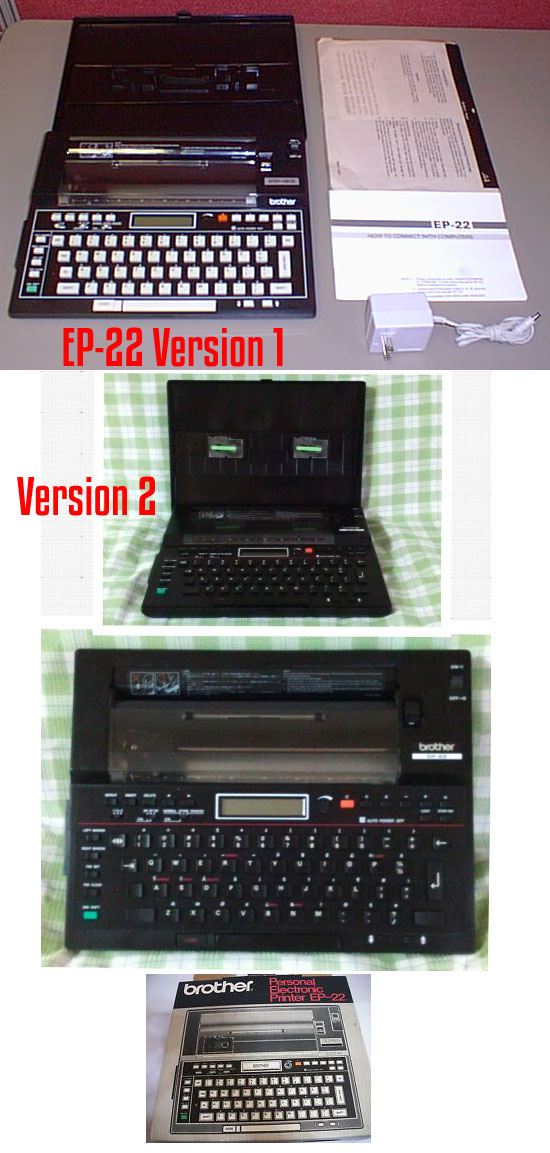 1984 – Brother EP-44, BP-30, EP-43, EP-45
1984 – Brother EP-44, BP-30, EP-43, EP-45
The EP-44 is introduced in 1984 with a slightly changed shell shape and color switched to white. It is unknown if the font is improved (Update: just got one and yes, it has a much better 24-pin NLQ typeface), but it does incorporate more buffer memory and retains the I/O port of the EP-22, giving it the ability to be used as a computer printer.
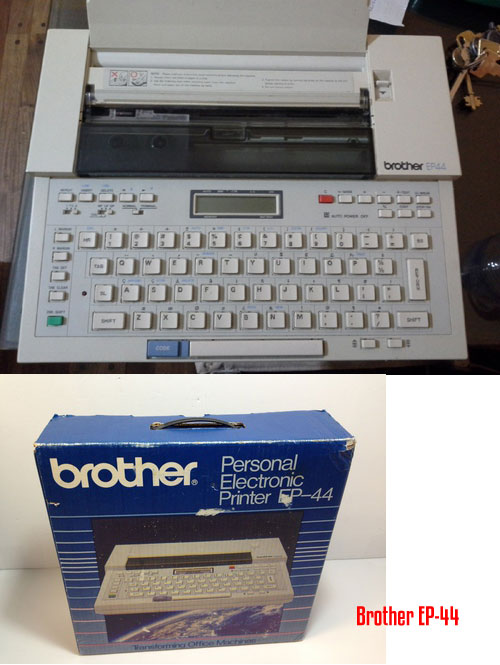 Also in 1984, Brother packages a 4-color pen plotter head in the EP typewriter format and calls it the BP-30 “Type-A-Graph”, giving it the ability to plot simple graphs as well as typewriting.
Also in 1984, Brother packages a 4-color pen plotter head in the EP typewriter format and calls it the BP-30 “Type-A-Graph”, giving it the ability to plot simple graphs as well as typewriting.
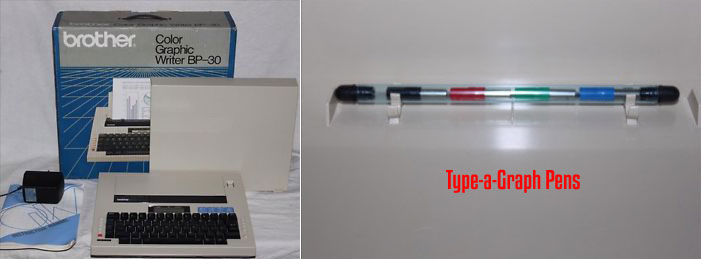
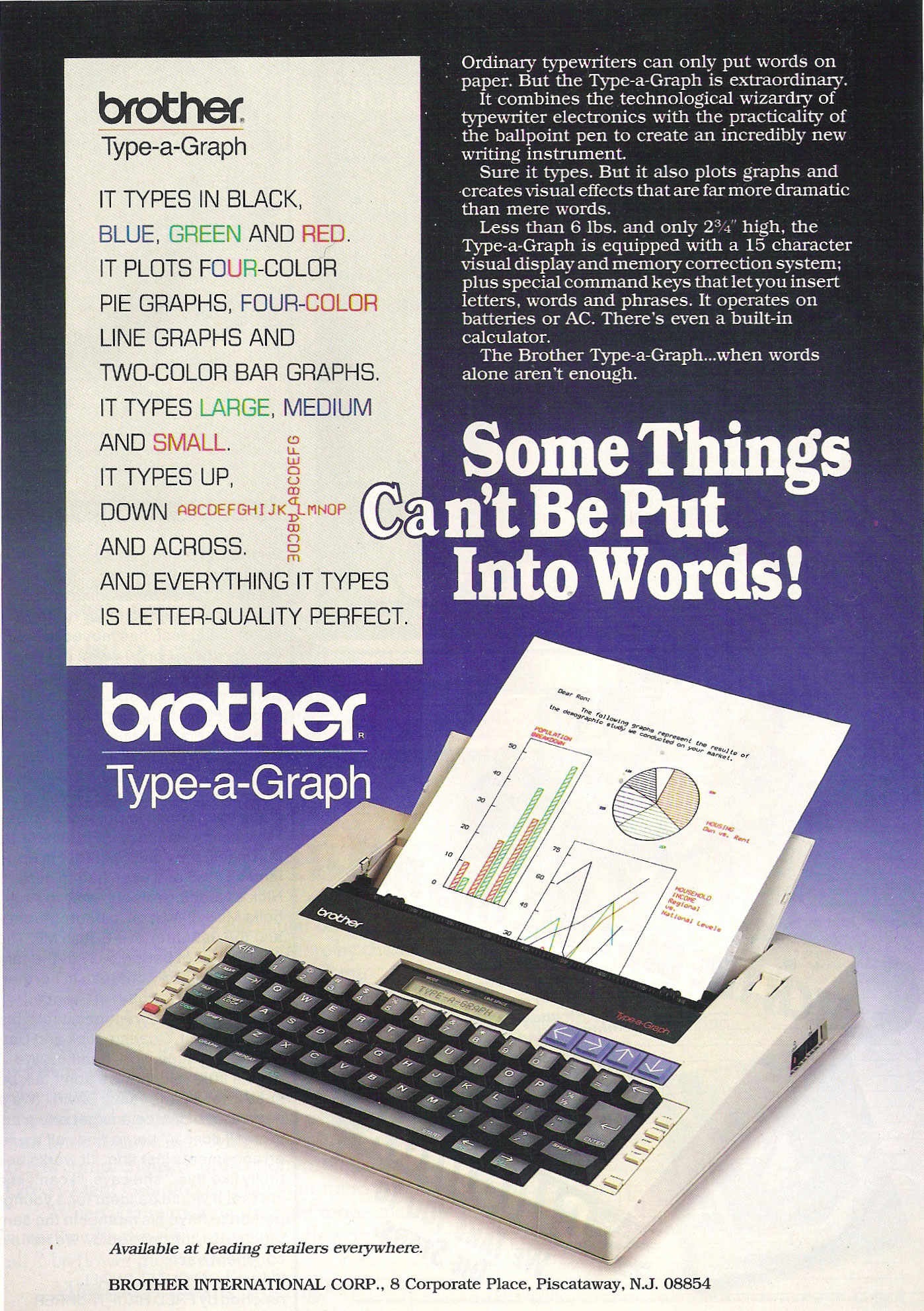 Later in 1984, Brother introduces a new design for the EP series shell, gives the EP a higher resolution print head and does away with the calculator-style keyboard, replacing it with a much better full-size keyboard.
Later in 1984, Brother introduces a new design for the EP series shell, gives the EP a higher resolution print head and does away with the calculator-style keyboard, replacing it with a much better full-size keyboard.
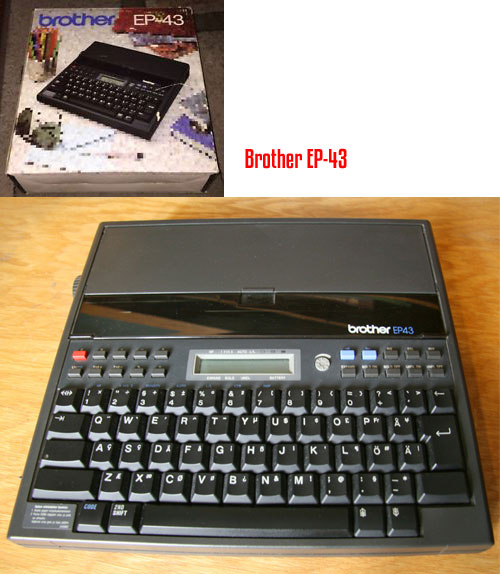
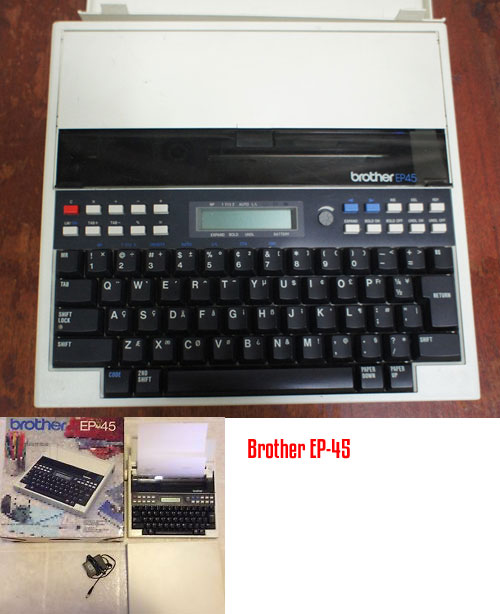 I have the parts and Service manuals for the EP-43/45 which indicate these models have multi-page memory. It also appears that the I/O port was done away with in these models.
I have the parts and Service manuals for the EP-43/45 which indicate these models have multi-page memory. It also appears that the I/O port was done away with in these models.
I came across a couple of ads in the December, 1984 and November, 1985 issues of Popular Photography listing the Brother EP models available for sale at those times. The EP-20 seems to have continued to be sold up until 1985, when it drops out of sight.
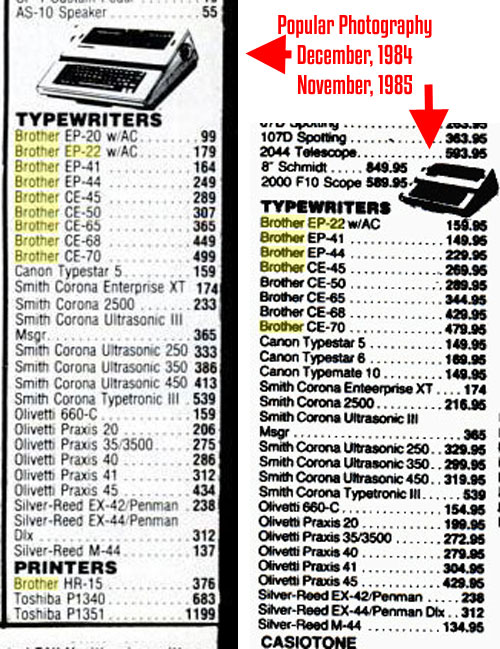 Note that these ads suggest 1985 as the introductory date of the popular Canon Typestar 6 and Typemate 10.
Note that these ads suggest 1985 as the introductory date of the popular Canon Typestar 6 and Typemate 10.
1987 – Brother EP-5, EP-150
I haven’t found out much about the EP-5 and EP-150, even though I have the parts and service manuals for both. The technical manuals make no mention of the functions or capabilities. I presume they are roughly similar to my Sharp machine, meaning much higher resolution fonts, and probably the ability to do several kinds of fonts. The I/O port from the EP-22/44 is not mentioned, and probably does not exist on these models.
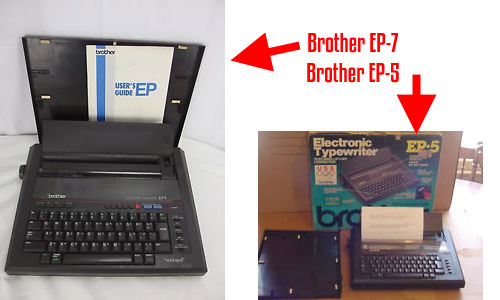
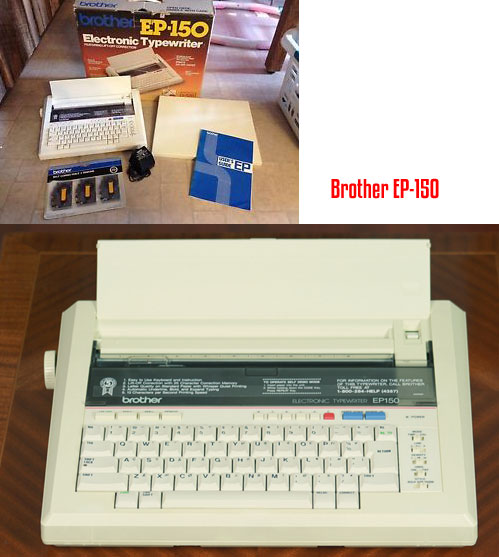 Beyond 1987/1988, I find no mention of any additional models. I did find mention that Brother’s thermal fax machine models were struggling at that time with poor sales, and it seems likely that the public’s disenchantment with thermal print technology and the quick rise of ever-better laptop computers in the 1980’s probably killed off the EP-Series typewriters. Certainly by the end of the 1980’s, the Baby Wedge era had ended, less than a decade after it had begun. Thermal printing technology had basically all but vanished from the consumer market and from then on was mainly used in low-cost industrial applications such as graphing printers (seismometers, EKG machines) and cash registers/ATMs.
Beyond 1987/1988, I find no mention of any additional models. I did find mention that Brother’s thermal fax machine models were struggling at that time with poor sales, and it seems likely that the public’s disenchantment with thermal print technology and the quick rise of ever-better laptop computers in the 1980’s probably killed off the EP-Series typewriters. Certainly by the end of the 1980’s, the Baby Wedge era had ended, less than a decade after it had begun. Thermal printing technology had basically all but vanished from the consumer market and from then on was mainly used in low-cost industrial applications such as graphing printers (seismometers, EKG machines) and cash registers/ATMs.
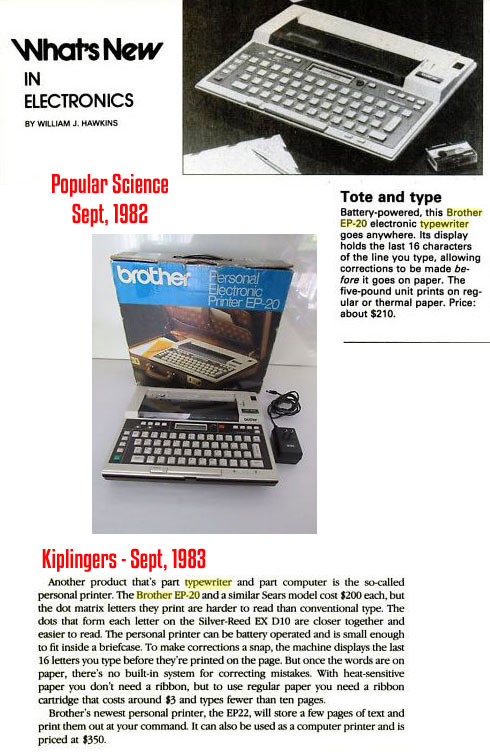
Does your Brother EP-20 have an AC adapter? Batteries are a nuisance to me (even Magic Batteries)
It takes a 6v adapter, but I don’t have one (:
I probably have a 6v adapter rattling around in a drawer – would you like it?
heh, thanks, but I’m pretty happy not tethering the things to a wall. I change my answer to “I probably do have dozens of 6v adapters (since I have a small fleet of TRS-80’s that also take the same adapter), but I’ll stick to untethered power.”
I think I still even have the weird little solar panel thing I used to use to extend battery life on the Trash-80’s by trickle-charging while I worked. I’d have to get rechargable D-cells, though, and do a bit of rewiring and soldering… Hmmn.
How much for one of your 6V adapter, as I don’t seem to find one here at home. thanks
You really have shed light on an obscure corner of typewriter history. With historical distance, these baby wedges do have their charm.
I didn’t need any historical distance. My best friend got one of these in 1983, and it was such a nifty little thing – I so coveted it.
I have one of the original Brother pen writers….bought it as I was intrigued by the ability to change colors as I wrote. I think it writes in several fonts, I’m pretty sure it it had italic. Later, I bought a Panasonic pen writer which had more features. It sits on its side next to my easy chair, and serves as a place for my coffee mug.
Good work. Not sure I’d want one, but interesting to read about them. :)
This is so cool. I like learning a bit more about my EP-44. I was eyeing the thermal paper at Office Max the other day, wondering if I could put it in the machine and use it again. I typed many a college paper on that little baby. :)
Thanks for the trip down memory lane. :)
ooh, you should upload it to the TWDB, we need an EP-44. also get a scan of the typeface, I’m curious if it still does the same dot-matrix font as the EP-20 and EP-22.
The EP-44 is, for intents and purposes, an EP-20. I used to own the 20, then when I bought a BBC Micro the 44 was the printer I bought to go with it. The 44 has a computer printer port and my unit was black, whereas the 20 was cream or beige.
These machines will print to ‘thermal’ fax paper without the ribbon in place. Just remember the fax paper only prints on one side! [usually, curl same as platen]
Just dusting off my EP45 now…still works like a charm. However, just peaked at cassette prices… Yikes! lol I agree… maybe a term paper were written on that baby.
I need the user manual for a brothers ep 45 and if possible the power cord tho I can use batteries…ty
Sandy
Hey Ted, you wouldn’t happen to know if the EP-45 runs on batteries, would you? The little Sharp I bought arrived, but is totally non-functional. :-/
Nevermind, I just saw Sandy’s comment, lol
Hey I know this is a very old thread but I was wondering if you knew anywhere to find a print head for an EP43. ?
Thanks, anything you could tell me helps.
probably not worth the effort. just get another EP43. they’re cheap and not particularly highly sought after.
I have an EP7 in my collection, I’ll take some pictures and add it to the TWDB.
Hi, do you happen to have service manual for EP-44. I have one that needs some tough love to get it back in working order.
Nope. I’m not sure how much use a service manual would be, anyway. Most of the repairs are component assembly replacements, and those replacements are unobtainium.
Well that’s a pity. My EP-44 has electrical issue with its switch mode power supply section, and I was hoping there would be some kind of schematic diagram describing component values and voltages. I have already changed capacitors and checked some of the transistors and diodes, but component layout is convoluted to follow without any diagrams. I can get it to turn on occasionally by repeatedly applying the power, but looks like I have to wait until a next thermal wedge turns up.
Howdy,
Would you be willing to share all or part of the EP-43 service manual? I seem to have a couple capacitors to replace on my EP-43 and I want to make sure and get the right ones.